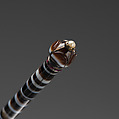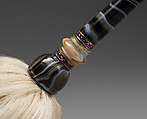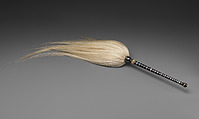Banded Agate and Gem-Set Fly-Whisk
Not on view
Fly whisks are an essential accessory in Indian court custom, and were operated by an attendant who stood near the royal seat of the Sultan, Emperor, or Maharaja. This jeweled object was likely made at the Mughal court (1526–1858) in the eighteenth century and used in ceremonies where the emperor was present. The handle of the whisk has been made up of many individual pieces of agate, layered together to create a striped pattern.
Carved hardstone objects are an important category of Indian decorative arts, and the exactitude in the slight tapering of the handle reveals the mastery of lapidaries in Mughal India. With its banded appearance, agate was sometimes cut to resemble the shape of an eye, and for that reason the material was thought to have a talismanic quality.
Due to rights restrictions, this image cannot be enlarged, viewed at full screen, or downloaded.
This artwork is meant to be viewed from right to left. Scroll left to view more.









